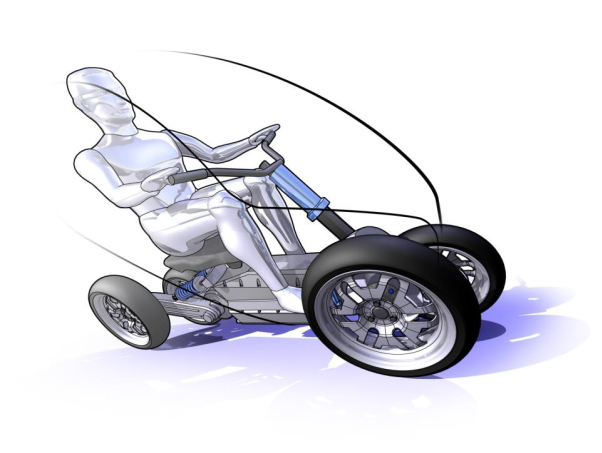Modelling and Simulations of a Narrow Track Tilting Vehicle
DOI:
https://doi.org/10.31273/eirj.v4i1.149Keywords:
narrow track vehicle, modelling, titling control, vehicle lateral dynamics, parameter estimationAbstract
Narrow track tilting vehicle is a new category of vehicle that combines the dynamical abilities of a passenger car with a motorcycle. In the presence of overturning moments during cornering, an accurate assessment of the lateral dynamics plays an important role to improve their stability and handling. In order to stabilise or control the narrow tilting vehicle, the demand tilt angle can be calculated from the vehicle’s lateral acceleration and controlled by either steering input of the vehicle or using additional titling actuator to reach this desired angle. The aim of this article is to present a new approach for developing the lateral dynamics model of a narrow track tilting vehicle. First, this approach utilises the well-known geometry ‘bicycle model’ and parameter estimation methods. Second, by using a tuning method, the unknown and uncertainties are taken into account and regulated through an optimisation procedure to minimise the model biases in order to improve the modelling accuracy. Therefore, the optimised model can be used as a platform to develop the vehicle control strategy. Numerical simulations have been performed in a comparison with the experimental data to validate the model accuracy.
Downloads
References
S. Kidane, L. Alexander, R. Rajamani, P. Starr and M. Donath. A fundamental investigation of tilt control systems for narrow commuter vehicles, Vehicle System Dynamics, Volume 42, 2008 - Issue 4.
J. Gohl, R. Rajamani, L. Alexander and P. Starr. Active roll mode control implementation on a narrow tilting vehicle, Vehicle System Dynamics, Volume 42, 2004 - Issue 5.
Furuichi H, Huang J, Matsuno T and Fukuda T. Dynamic model of three wheeled narrow tilting vehicle and optimal tilt controller design. In: IEEE international symposium on micro-nanomechatronics and human science, Nagoya, Japan, November 2012.
N. Amati, A. Festini, L. Pelizza and A. Tonoli. Dynamic modelling and experimental validation of three wheeled tilting vehicles, Vehicle System Dynamics, Volume 49, 2011 - Issue 4.
S. Maakaroun, Ph. Chevrel, M. Gautier and W. Khalil. Modeling and simulation of a two wheeled vehicle with suspensions by using robotic formalism. In: Proc. 18th IFAC World Congress, Milano, Italy, 2011.
J.H. Berote. Dynamics and control of a tilting three wheeled vehicle, Ph.D. Dissertation, University of Bath, UK, 2010.
J. Ryu. State and parameter estimation for vehicle dynamics control using GPS, Ph.D. Dissertation, Stanford University, USA, 2004.
J.C Gerdes and Y-H Judy Hsu. A Feel for the Road: A Method to Estimate Tire Parameters Using Steering Torque, AVEC, Dept. of Mechanical Engineering, Stanford University, USA, 2006.
C. Lundquist and T.B. Schön. Recursive identification of cornering stiffness parameters for an enhanced single track model, Division of Automatic Control, Department of Electrical Engineering, Linköpings Universitet, Sweden, 2009.
S.G. So and D. Karnopp. Switching strategies for narrow ground vehicles with dual mode automatic tilt control, International Journal of Vehicle Design, Volume 18 1997 - Issue 5.
H.B. Pacejka and E. Bakker. Magic formula tyre model, Vehicle System Dynamics, Volume 21, 1992 – Issue sup001.
H. B. Pacejka. Tyre and vehicle dynamics, 3rd Edition, Butterworth-Heinemann, 2012.
A.V Poelgeest. The dynamics and control of a three-wheeled tilting vehicle, Ph.D. Dissertation, University of Bath, UK, 2011.

Downloads
Published
Issue
Section
License
Authors who publish with this journal agree to the following terms:
Authors retain copyright and grant the journal right of first publication with the work simultaneously licensed under a Creative Commons Attribution License (CC-BY), which permits use and redistribution of the work provided that the original author and source are credited, a link to the license is included, and an indication of changes which were made. Third-party users may not apply legal terms or technological measures to the published article which legally restrict others from doing anything the license permits.
If accepted for publication authors’ work will be made open access and distributed under a Creative Commons Attribution (CC-BY) license unless previously agreed with Exchanges’ Editor-in-Chief prior to submission.
Authors are able to enter into separate, additional contractual arrangements for the non-exclusive distribution of the journal's published version of the work (e.g., post it to an institutional repository or publish it in a book), with an acknowledgement of its initial publication in this journal.
Authors are permitted and encouraged to post their work online (e.g., in institutional repositories or on their website) prior to and during the submission process, as it can lead to productive exchanges, as well as earlier and greater citation of published work. (see: The Effect of Open Access)
